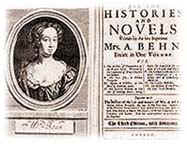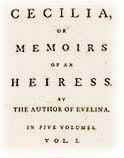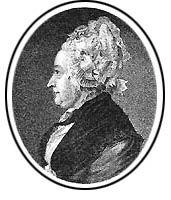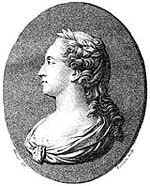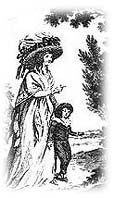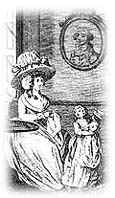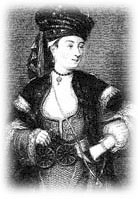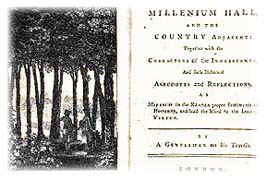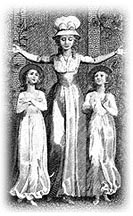Aphra Behn || Fanny Burney || Elizabeth Carter
|| Mlle. Clairon || Mrs. Lovechild
Often credited with being the first woman writer to earn a living by her pen, Behn apparently led a most unusual and eventful life. Although the details concerning her life are scant and often based on speculation, evidence suggests that in her youth she visited Surinam, where she had an affair with the political radical William Scot. Returning to England, she may have married a "Mr. Behn" in 1664; however, she was probably widowed and penniless by 1665. To earn money, she took employment by the Crown as a spy in Antwerp, but arrived back in England in debt, and in 1668 was thrown in debtor’s prison. Upon her emergence, she started to support herself by writing plays for the London theater, and later novels for print. She is best known for Oroonoko; or, The Royal Slave (1688), the story of a captured African prince who is forced into slavery in Surinam. Oroonoko is at once an adventure narrative and a horrific tale of the African experience in the New World. Overall, Behn composed at least sixteen plays for the stage, and wrote fourteen novels, only six of which were published during her lifetime.
Fanny Burney, 1752-1840 Burney’s novels were immensely popular during the late eighteenth century. However, Burney herself had to overcome family disapproval in order to make a name among English literary circles. Her father, Charles Burney, a renowned musicologist, discouraged his daughter’s literary activity and provided her with no formal education. In spite of this, she read widely and began writing at a young age. But at the age of fifteen, in response to her father and perhaps her stepmother’s objections to imaginative poetry, plays, and stories, she dramatically sacrificed all of her writings to a huge bonfire. Not completely deterred, she resumed writing and anonymously published her first novel, Evelina (1778), which became a great success. Evelina won Burney not only her father’s approval, but also writer and critic Dr. Samuel Johnson’s. She went on to secure a place in Queen Charlotte’s court and in English literary society. She later left court to marry French émigré General Alexandre D’Arblay (1791) and lived until the age of eighty-seven. Her novels deal with women’s roles in relation to the British aristocracy, marriage, wealth, and power. Her successful works influenced other women writers, including Jane Austen, whose name is among the list of subscribers to Camilla. Camilla: Or, a Picture of Youth by the Author of Evelina and Cecilia. London: Printed for T. Payne, T. Cadell, and W. Davies, 1796. 5 vols. First edition. Burney’s fourth published novel involves the "courtship of lighthearted Camilla by somber Edgar. Led by his tutor Marchmont, a misogynist, to demand perfection and the full possession of his lady’s heart before he declares himself, Edgar puts Camilla through a series of tests and suffers torments of misapprehension and jealously, for the girl has been warned by her father never to let her feelings show" (Doody). Elizabeth Carter, 1717-1806 Carter, known for her translations, poetry, essays, and letter writing, was fortunate enough to be educated by her father, the Perpetual Curate in Deal, England. Learning alongside her brothers, she received a well-rounded education, which included knowledge of several languages. She was skilled in Latin, Greek, Hebrew, French, Italian, Spanish, and German. As an adult, she taught herself Portuguese and Arabic. According to tradition, Carter lost her health by studying long nights as a child, and did in fact suffer from severe headaches as an adult. Her father was a friend of Gentleman’s Magazine editor, Edward Cave, who began to publish Carter in his periodical. She became active in England’s literary circles and developed friendships with Samuel Johnson, Catherine Talbot, Elizabeth Montagu, Samuel Richardson, Edmund Burke, Horace Walpole, and Hannah More.
A Series of Letters between Mrs. Elizabeth Carter and Miss Catherine Talbot, from the Year 1741 to 1770: To Which Are Added, Letters from Mrs. Elizabeth Carter to Mrs. Vesey, between the Years 1763 and 1787; Published from the Original Manuscripts in the Possession of the Rev. Montagu Pennington. London: Printed for F.C. and J. Rivington, 1809. 4 vols. First edition. Mlle. Clairon (Claire-Josèphe-Hippolyte Léris de la Tude), 1723-1803 Clairon began acting on the French stage in her youth and, as an adult, became one of the greatest tragediennes of the seventeenth century. She was persuaded by her lover, the critic Marmontel, to abandon the "solemn, declamatory style of the day" for a more "conversationally direct form of diction." Before her career was over, Clairon attained the admiration of Voltaire and Garrick. She retired from the theater in 1764 and opened a school for young actors.
Mary Masters, 1706?-1759? Not a great deal is known about Mary Masters. According to James Boswell, she was acquainted with Samuel Johnson, who may have helped to edit some of her verses. She is also linked with Edmund Cave, editor of Gentleman’s Magazine. She advocates women’s rights in her Familiar Letters and Poems on Several Occasions (1755): "a Woman is equal to a Man, as being of the same Species, and endow’d with every Faculty which distinguishes him from the Brutes." Poems on Several Occasions. London: Printed by T. Browne for the author, 1733.Sarah Jennings Churchill, Duchess of Marlborough, 1660-1744 The influential and opportunistic Duchess of Marlborough entered court as a maid of honor for Anne Hyde, the Duchess of York, and eventually advanced to become an intimate and influential confidante to Queen Anne. She and husband, John Churchill, hid the former princess Anne during the exile of Roman Catholic James II (1688) and thus secured high positions in court for a time. Unwise political moves and inattentiveness to the Queen later led to the Duchess’ disfavor and ejection from court (1710). Her courtly ambition and outspokenness contributed to her illustrious public reputation. Samuel Johnson and Robert Walpole were highly critical of her. Pope unattractively modeled his character "Atossa" from Ethic Epistles (Moral Essays) on her life, which led the Duchess to arrange for the work’s suppression. However, Henry Fielding did publish in her defense A Full Vindication of the Duchess-Dowager of Marlborough (1742). During the end of her life, she authored An Account of the Conduct with the help of Nathaniel Hooke. An Account of the Conduct of the Dowager Duchess of Marlborough, from Her First Coming to Court, to the Year 1710. In a Letter from Herself to My Lord—. London: Printed by James Bettenham, for George Hawkins, 1742. Elizabeth Robinson Montagu, 1720-1800 Younger sister of novelist Sarah Scott, Elizabeth Robinson Montagu was educated at home and read widely. Active in literary circles, she became known as "Queen of the Bluestockings," a circle of women who promoted literary and intellectual exchanges. She invited educated guests to her gothic house at Sandleford, where she encouraged intelligent conversation between both women and men. Through her gatherings, she made friendships with Samuel Johnson, Hester Thrale, David Garrick, Edmund Burke, and Horace Walpole. In her popular Essay on the Writings and Genius of Shakespear, she defends Shakespeare against Voltaire by comparing him with French and Greek dramatists, and sets Shakespeare up as a great figure worthy of national pride. An Essay on the Writings and Genius of Shakespear, Compared with the Greek and French Dramatic Poets with Some Remarks upon the Misrepresentations of Mons. de Voltaire. London: Printed for J. Dodsley . . . , 1769. First edition. Lady Mary Wortley Montagu, 1689-1762 Lady Mary Wortley Montagu, cousin of writer Henry Fielding, was born in London to parents of the aristocracy. Her father, Evelyn Pierrepoint, later became the first Duke of Kingston. She eloped with Edward Wortley (1712) and the two became active in court. Through social activities, she made social contacts with several literary figures, including John Gay and Alexander Pope, although Pope later attacked her in print. From 1716 to 1718, her husband served as ambassador to Turkey, where Montagu wrote her Embassy Letters. At age 47, she shared an infatuation with Francesco Algarotti, a 24-year-old native Italian with literary promise. She moved to Italy to join Algarotti and, although their relationship cooled, remained on the Continent for the next twenty years. Montagu distributed her writings privately and was content not to publish avidly during her lifetime. With the exception of some anonymous articles and a pirated edition of her poetry, her letters, essays, and poems were published posthumously. In her works, she advocated higher education for women and, in turn, more political interest and involvement. The Works of the Right Honorable Lady Mary Wortley Montagu. Including Her Correspondence, Poems, and Essays. Published by Permission from Her Genuine Papers. London: Printed for Richard Phillips, 1803. 5 vols. This particular imprint is one of two editions of Montagu’s first collected works released in 1803 by Phillips. It appears to be quite rare, as no other copies of this edition have been located.
Hannah More, 1745-1833 Hannah More was one of the most prolific and widely read writers of her time. Educated as a schoolmistress, she soon began publishing plays for the instruction of children and, later, religious writings, including several chapbooks for youths. She also became a part of Samuel Johnson’s illustrious circle. Besides being a writer, she was a committed religious and social reformer, establishing Sunday schools for the poor. She encouraged other women to volunteer their time to helping the poor and, as a result, increased women’s influence in social work. However, although she advocated female education, she did so only in the context of an educated domesticity. In her only novel, Coelebs in Search of a Wife, she stresses the role of the subservient wife. Ironically, More, herself, never married or entered into a domestic situation. She "died friendless and alone, the victim of servants who mistreated her" (Horwitz). Sir Eldred of the Bower and the Bleeding Rock: Two Legendary Tales. London: Printed for T. Cadell, 1776. First edition Hints toward Forming the Moral Character of a Young Princess. London: Printed for T. Cadell and W. Davies, in the Strand, 1819. Fifth edition. Inscribed by Hannah More to Lady Arland. The volumes each include fore-edge paintings.Sarah Pennington, ?-1783 An Unfortunate Mother’s Advice to Her Absent Daughters in the Letter to Miss Pennington. London: Printed by H. Hughes for J. Walter, 1773. Sixth edition. Sarah Pennington began writing after a publicly and personally painful separation from her husband, Joseph Pennington, and their several children. The reasons behind their separation are unclear, although Sarah admits to behaving like a "coquette." Her four publications are often autobiographical and remorseful. An Unfortunate Mother’s Advice was her most popular work. It went through three editions the year it was released (1761) and at least seven more by 1800. Hester Lynch Thrale Piozzi, 1741-1821 Piozzi was born into the English aristocracy and well educated. In 1763, after her father’s death, her mother forced her into an unloving marriage with Henry Thrale, a wealthy brewer, by whom she had twelve children—only four living to adulthood. In 1765, she met Samuel Johnson and helped him with a translation of Boethius. Through Johnson, she was introduced to several popular figures, including Fanny Burney, David Garrick, Oliver Goldsmith, and Sir Joshua Reynolds. After her husband’s death, she chose to marry a man both Italian and Roman Catholic, Gabriel Piozzi. Her decision to marry both a foreigner and a Catholic was controversial, and ruined her relationship with Johnson, who adamantly opposed the union. Despite objections, their marriage was highly successful. During the time of their travels on the Continent and later settling in Wales, she became a prolific writer of histories, travel accounts, and poetry. Anecdotes of the Late Samuel Johnson, LL.D. during the Last Twenty Years of His Life. London: Printed for T. Cadell, 1786. Second edition. First published in 1786, Anecdotes is Piozzi’s best known work. It is considered to be one of the most authoritative contemporary accounts of Johnson’s life. British Synonymy; or, An Attempt at Regulating the Choice of Words in Familiar Conversation. Inscribed, with Sentiments of Gratitude and Respect, to Such of Her Foreign Friends as Have Made English Literature Their Peculiar Study. Dublin: Printed by William Porter for P. Byrne, and W. Jones, 1794. Sarah Scott, 1723-1795 Elder sister to writer Elizabeth Montagu, Scott grew up in a family that valued education. Scott was briefly, and apparently unhappily, married to a George Lewis Scott. After her family "rescued" her from the marriage, she went to live with Lady Barbara Montagu (unrelated) and began an active life of charity work and writing. She tried to start a "utopian community" with her sister, Elizabeth, and friends. Her novel, A Description of Millenium Hall, idealizes her utopian ideals. Her novels were published anonymously and sold quite well. Although they lost popularity in the nineteenth century, her work has recently been reprinted.
Mary Wollstonecraft, 1759-1797 After surviving an unhappy childhood with an alcoholic and violent father, Mary Wollstonecraft spent time as a lady’s companion, a schoolmistress, and a governess. Later, her life took a dramatic turn. Beginning in 1794, she visited France and Scandinavia. She had a daughter out of wedlock with an American businessman and attempted suicide when their relationship failed. She then had an affair with British author William Godwin, and the two married after she became pregnant. Sadly, she died shortly after giving birth to a daughter, Mary, who would later be known as Mary Shelley, author of Frankenstein. Wollstonecraft’s diversified writings include subjects such as education, travel, history, politics, and women’s rights. She is best known for A Vindication of the Rights of Woman (1792).
|
